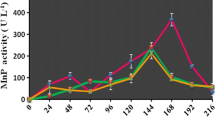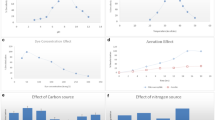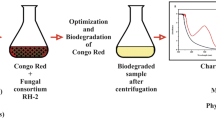Abstract
Textile effluent carries a range of dyes that may be recalcitrant and resistant to biodegradation. A unique consortium of the Fimbristylis dichotoma and Saccharomyces cerevisiae is exploited for the biodegradation of an azo dye Rubine GFL and actual textile effluent. This consortium enhances the rate of biodegradation of Rubine GFL and actual textile effluent with an excellent rate of biodegradation of 92% for Rubine GFL and 68% for actual textile effluent when compared to the individual one within 96 h. Speedy decolorization of Rubine GFL and actual textile effluent was observed due to the induction of oxido-reductive enzymes of the FD-SC consortium. Along with the significant reduction in the values of COD, BOD, ADMI, TSS, and TDS with 70, 64, 65, 41, and 52%, respectively, in experimental sets treated with FD-SC consortium. The biodegradation of Rubine GFL was confirmed with UV-Vis spectroscopy at the preliminary level, and then, metabolites formed after degradation were detected and identified by FTIR, HPLC, and GC-MS techniques. Also, decolorization of the dye was observed in the sections of the root cortex of Fimbristylis dichotoma. The toxicity of dye and metabolites formed after degradation was assessed by seed germination and bacterial count assay, where increased germination % and bacterial count from 31×107CFUs to 92 × 107 CFUs reflect the nontoxic nature of metabolites. Furthermore, the nontoxic nature of metabolites was confirmed by fish toxicity on Cirrhinus mrigala showed normal structures of fish gills and liver in the groups treated with FD-SC consortium proving the better tactic for biodegradation of dyes and textile effluent.








Similar content being viewed by others
Data availability
All data generated or analyzed during this study are included in this published article .
Abbreviations
- TDS:
-
Total dissolved solids
- COD:
-
Chemical oxygen demand
- TSS:
-
Total suspended solids
- BOD:
-
Biological oxygen demand
- HPLC:
-
High-performance liquid chromatography
- mM:
-
Millimolar
- h:
-
Hour
- D/W:
-
Distilled water
- A:
-
Ampere
- ppm:
-
parts/ million
- F. dichotoma :
-
Fimbristylis dichotoma
- S. cerevisiae :
-
Saccharomyces cerevisiae
- CFUs:
-
Colony forming units
- w/v:
-
Weight by volume
- Chl a:
-
Chlorophyll a
- Chl b:
-
Chlorophyll b
- cm:
-
Centimeter
- NADPH:
-
Nicotinamide adenine dinucleotide phosphate
- ABTS:
-
2,2-Azino-bis(3-ethylbenzothiazoline)-6-sulfonic acid
- NAD:
-
Nicotinamide adenine dinucleotide
- DAB:
-
3′,3′-Diaminobenzidine tetrahydrochloride
- DCIP:
-
2,6-Dichlorophenol indophenol
- GG-BL:
-
Galactomyces geotrichum and Brevibacillus laterosporus
- CI:
-
Color index
- RT:
-
Room temperature
- MTPI:
-
Mahesh textile processing industries
- OD:
-
Optical density
- mL:
-
Milliliter
References
Ali SS, Al-Tohamy R, Xie R, El-Sheekh MM, Sun J (2020) Construction of a new lipase- and xylanase-producing oleaginous yeast consortium capable of reactive azo dye degradation and detoxification. Biores Tech 313:123631
Bankole PO, Adekunle AA, Obidi OF, Olukanni OD, Govindwar SP (2017) Degradation of indigo dye by a newly isolated yeast, Diutina rugosa from dye wastewater polluted soil. J Environ Chem Eng 5:4639–4648
Chandanshive V, Kadam S, Rane N, Jeon B-H, Jadhav J, Govindwar S (2020) In situ textile wastewater treatment in high-rate transpiration system furrows planted with aquatic macrophytes and floating phytobeds. Chemosphere 252:126513
Chandanshive VV, Kadam SK, Khandare RV, Kurade MB, Jeon Byong-Hun, Jadhav JP, Govindwar SP (2018) In situ phytoremediation of dyes from textile wastewater using garden ornamental plants, effect on quality and plant growth. Chemosphere 210:968–976
Chandanshive V, Rane N, Gholave A, Patil S, Jeon B-H, Govindwar S (2016) Efficient decolorization and detoxification of textile industry effluent by Salvinia molesta in lagoon treatment. Environ Res 150:88–96
Chandanshive VV, Rane NR, Tamboli AS, Gholave AR, Khandare RV, Govindwar SP (2017) Co-plantation of aquatic macrophytes Typha angustifolia and Paspalum scrobiculatum for effective treatment of textile industry effluent. J Haz Mate 338:47–56
Chaudhari A, Paul D, Thamke V, Bagade A, Kodam K (2022) Concurrent removal of reactive blue HERD dye and Cr(VI) by aerobic bacterial granules. J Clean Prod 367:133075
Chougule AS, Jadhav SB, Jadhav JP (2014) Microbial degradation and detoxification of synthetic dye mixture by Pseudomonas sp. SUK 1. Proc Natl Acad Sci India Sect B: Biol Sci 84:1059–1068
El-Sayed G, Mahmoud HM, El-Komy AM (2018) Biotreatment of water polluted with methyl orange dye by using different forms of yeast. J Basic Env Sci 5:217–221
Gombert AK, Van Maris AJ (2015) Improving conversion yield of fermentable sugars into fuel ethanol in first-generation yeast-based production processes. Curr Opin Biotechnol 33:81–86
Gurav R, Bhatia S, Choi T-R, Choi Y-k, Kim H-J, Song H, Lee SM, Park SL, Lee HS, Koh J, Jong-Min J, Yoon J-J, Yang Y-H (2020) Application of macroalgal biomass derived biochar and bioelectrochemical system with Shewanella for the adsorptive removal and biodegradation of toxic azo dye. Chemosphere 264:128539
Jadhav JP, Govindwar S (2006) Biotransformation of malachite green by Saccharomyces cerevisiae MTCC 463. Yeast 23:315–323
Jadhav JP, Parshetti GK, Kalme SD, Govindwar SP (2007) Decolourization of azo dye methyl red by Saccharomyces cerevisiae MTCC 463. Chemosphere 68:394
Jadhav RR, Chaudhari AU, Patil DN, Kodam KM, Jadhav JP (2023) In situ treatment of real textile effluent in constructed furrows using consortium of Canna indica and Saccharomyces cerevisiae and subsequent biochemical and toxicity evaluation. Environ Pol 327:121583
Kabra AN, Khandare RV, Govindwar SP (2013) Development of a bioreactor for remediation of textile effluent and dye mixture: a plant-bacterial synergistic strategy. Water Res 47:1035–1048
Kadam SK, Chandanshive VV, Rane NR, Patil SM, Gholave AR, Khandare RV, Bhosale AR, Jeon B-H, Govindwar SP (2018) Phyto beds with Fimbristylis dichotoma and Ammannia baccifera for treatment of real textile effluent: An in-situ treatment, anatomical studies and toxicity evaluation. Environ Resear 160:1–11
Kadam SK, Tamboli AS, Chandanshive VV, Govindwar SP, Choo Y-S, Pak J-h (2022) Construction and implementation of floating wetpark as effective constructed wetland for industrial textile wastewater treatment. J Haza Mate 424:127710
Khandare RV, Desai S, Bhujbal S, Govindwar SP (2017) Phytoremediation of fluoride with garden ornamentals Nerium oleander, Portulaca oleracea and Pogonatherum crinitum. Environ Sci Pol Res 24:7
Khandare RV, Govindwar SP (2015) Phytoremediation of textile dyes and effluents: current scenario and future prospects. Biotech Adv 33:1697–1714
Khandare RV, Rane NR, Waghmode TR, Govindwar SP (2016) Bacterial assisted phytoremediation for highly sulphonated diazo reactive dye. Envi Sci Pol Res 19:1709–1718
Kulkarni AN, Watharkar AD, Rane NR, Jeon B-H, Govindwar SP (2018) Decolorization and detoxification of dye mixture and textile effluent by lichen Dermatocarpon vellereceum in fixed bed upflow bioreactor with subsequent oxidative stress study. Ecotox And Env Safe 148:17–2546
Kumar V, Giria BS, Razab N, Roya K, Kimd K-H, Raia BN, Singh RS (2018) Recent advancements in bioremediation of dye: current status and challenges. Biores Techno 253:355–367
Kurade MB, Ha Y-H, Xiong J-Q, Govindwar SP, Jang M, Jeon B-H (2021) Phytoremediation as a green biotechnology tool for emerging environmental pollution: a step forward towards sustainable rehabilitation of the environment. Chem Eng J 415:129040
Kurade MB, Waghmode TR, Khandare RV, Jeon B-H, Govindwar SP (2015) Biodegradation and detoxification of textile dye Disperse Red 54 by Brevibacillus laterosporus and determination of its metabolic fate. J Biosci Bioeng 20:1–8
Kurade MB, Waghmode TR, Patil SM, Jeon B-H, Govindwar SP (2017) Monitoring the gradual biodegradation of dyes in a simulated textile effluent and development of a novel triple layered fixed bed reactor using a bacterium yeast consortium. Chem Eng J 307:1026–1036
Kurade MB, Waghmode TR, Xiong J-Q, Govindwar SP, Jeon B-H (2019) Decolorization of textile industry effluent using immobilized consortium cells in upflow fixed bed reactor. J Clean Prod 213:884–891
Lowry OH, Rosebrough NJ, Farr AL, Randall RJ (1951) Protein measurement with the Folin-phenol reagent. J Biol Chem 193:265–275
Nikam M, Patil S, Patil U, Khandare R, Govindwar S, Chaudhari A (2017) Biodegradation and detoxification of azo solvent dye by ethylene glycol tolerant ligninolytic ascomycete strain of Pseudocochliobolus verruculosus NFCCI 3818. Biocatal Agri Biotech 9:217–221
Paul OB, Adedotun AA, Olayide FO, Chandanshive VV, Govindwar SP (2018) Biodegradation and detoxification of scarlet RR dye by a newly isolated filamentous fungus, Peyronellaea prosopidis. Sust Env Res 28:214–222
Rane N, Tapase S, Kanojia A, Watharkar A, El-Sayed S, Jang M, Yadav K, Amin M, Marina MS, Cabral P, Jadhav JP, Jeon B-H (2022) Molecular insights into plant–microbe interactions for sustainable remediation of contaminated environment. Biores Tech 344:126246
Rane NR, Patil SM, Chandanshive VV, Kadam SK, Khandare RV, Jadhav JP, Govindwar SP (2016) Ipomoea hederifolia rooted soil bed and Ipomoea aquatica rhizofiltration coupled phytoreactors for efficient treatment of textile wastewater. Water Res 96:1–11
Sutar S, Otari S, Jadhav J (2022) Biochar based photocatalyst for degradation of organic aqueous waste: a review. Chemosphere 287:132200
Thanavel M, Bankole PO, Kadam S, Govindwar S, Sadasivam SK (2019) Desulfonation of the textile azo dye Acid Fast Yellow MR by newly isolated Aeromonas hydrophila SK16. Water Res Ind 22:100–116
Vyavahare G, Jadhav P, Jadhav J, Patil R, Aware C, Patil D, Gophane A, Yang Y-H, Gurav R (2018) Strategies for crystal violet dye sorption on biochar derived from mango leaves and evaluation of residual dye toxicity. J Clean Prod 207:296–305
Watharkar A, Jadhav J (2014) Detoxification and decolorization of a simulated textile dye mixture by phytoremediation using Petunia grandiflora and, Gailardia grandiflora: a plant–plant consortial strategy. Ecotoxicol Environ Safe 103:1–8
Watharkar AD, Kadam SK, Khandare RV, Kolekar PD, Jeon B-H, Jadhav JP, Govindwar SP (2018) Asparagus densiflorus in a vertical subsurface flow phytoreactor for treatment of real textile effluent: a lab to land approach for in situ soil remediation. Ecotox Env Safe 161:70–77
Yan A, Yamin W, Tan SN, Mohamed LMY, Ghosh S, Chen Z (2020) Phytoremediation: a promising approach for revegetation of heavy metal polluted land. Front In Life Sci 11:359
Yang L, Wang J, Yang Y, Li S, Wang T, Oleksak P, Chrienova Z, Qinghua W, Nepovimova E, Zhang X, Kuca K (2022) Phytoremediation of heavy metal pollution: hotspots and future prospects. Ecotoxicol Env Safe 234:113403
Zahra K, Tayebe BL, Amir H, Fereshteh S (2019) Microbial degradation of azo dye carmoisine in aqueous medium using Saccharomyces cerevisiae ATCC 9763. J Hazard Mate 373:608–619
Acknowledgement
Mr. Rahul R. Jadhav is thankful to Chhatrapati Shahu Maharaj Research, Training, and Human Development Institute (SARTHI), Pune, Government of Maharashtra for providing the CSMNRF-2019 fellowship award. Dr. Savita R. Tapase is thankful to University Grant Commission (UGC), India for providing Dr. D. S. Kothari postdoctoral fellowship (2006(BSR)/BR/18-19/0343). Prof. Jyoti P. Jadhav is thankful to DBT, New Delhi, India, for for SUK-IPLS program (BT/PR4572/INF/22/147). Dr. Vishal V. Chandanshive is thankful to DBT, New Delhi (Grant No. BT/PR18965/BCE/8/1401/2016 dated 15- 06-2017) for providing Senior Research Fellowship. Also, all authors are thankful to Shivaji University, Kolhapur for providing lab and research facility.
Author information
Authors and Affiliations
Contributions
All authors contributed to the study's conception and design. Material preparation, data collection, and analysis were performed by Rahul R. Jadhav, Savita R. Tapase, and Anna D. Gophane. The first draft of the manuscript was written by Rahul R. Jadhav and all authors commented on previous versions of the manuscript. All authors read and approved the final manuscript.
Corresponding author
Ethics declarations
Ethics approval and consent to participate
Not applicable
Consent for publication
Not applicable
Competing interests
The authors declare no competing interests.
Additional information
Publisher’s Note
Springer Nature remains neutral with regard to jurisdictional claims in published maps and institutional affiliations.
Rights and permissions
Springer Nature or its licensor (e.g. a society or other partner) holds exclusive rights to this article under a publishing agreement with the author(s) or other rightsholder(s); author self-archiving of the accepted manuscript version of this article is solely governed by the terms of such publishing agreement and applicable law.
About this article
Cite this article
Jadhav, R.R., Tapase, S.R., Chandanshive, V.V. et al. Plant and yeast consortium for efficient remediation of dyes and effluents: a biochemical and toxicological study. Int Microbiol (2024). https://doi.org/10.1007/s10123-023-00464-9
Received:
Revised:
Accepted:
Published:
DOI: https://doi.org/10.1007/s10123-023-00464-9




